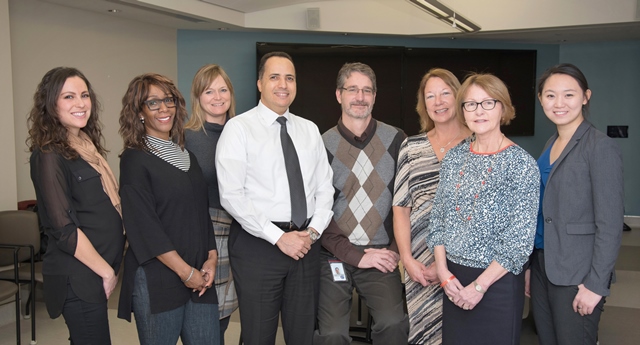By Yuki Wu
Patients with chronic diseases require care that spans across the healthcare continuum, inclusive of care within the hospital, in the community and most importantly – in their own home. The complexity in their care leads to prolonged hospital stay and frequent hospital readmissions for these patients.
The Connecting Care to Home (CC2H) program is jointly developed by the London Health Sciences Centre (LHSC), the South West Local Health Integration Network (SW-LHIN) Home and Community Care, St. Joseph’s Health Care London and Thames Valley Family Health Team. It is one of the pilots under the Ontario Ministry of Health and Long Term Care (MoHLT), delivering care under an Integrated Funding Model (IFM). CC2H aims to better integrate care for specific cohorts that experience higher rates of ED visit and readmissions following a hospital stay, improving patient experience and disease trajectory, and decrease overall healthcare cost. Patients who were enrolled in the program has reported positive experience with the team and improved self-care confidence. Overall, in the first year the program has decreased 30-day patient readmission rates by 42 per cent and reduced overall health cost by 58 per cent.
At the core of the CC2H team are an in-hospital navigator, a Clinical Care Coordinator (CLCC) from the LHIN, and a Direct Response Nurse (DRN) from the designated homecare team. The team communicates with hospital and community providers alike, provides real-time monitoring and updates, and provides personalized self-care management education to patients. Patients are provided with education materials, a 24-hour phone line that links them with the DRN, and key equipment that are important for their clinical indicators such as blood pressure cuffs and weigh scales.
Prior to implementation, a broad team of stakeholders were engaged. The core project team, navigators, CLCCs and community providers designed alongside hospital operation leaders and physicians leaders the first “future state” process maps to guide their work. The designing of the process was extensive, with goals including appropriate patient assessment and selection, communication and engagement of providers in differed care settings while patient is on program and the transition of most responsible physicians as patients are discharged.
The planned future state included a few “potential processes” where the team was unsure whether it will work efficiently with the current system structures in place. These were identified prior to the implementation as
Plan-Do-Study-Act (PDSA) Topics. Measures were determined by the team and continuous data collection occurred to understand whether these processes were successful. Data were analyzed on a periodic basis at 5 patients, 25 patients, 50 patients so on, or every 3 months, whichever occurred sooner.
One of the PDSA Topics is the Risk Stratification Tool used by navigators. The Risk Stratification Tool includes important clinical and care indicators that would guide the navigators to understand patient’s appropriateness for the CC2H program. After data analyses and feedback, it was found that some patients were inappropriate for enrollment, regardless of their Risk Stratification Scores. Exclusion criteria were added to address this issue. For example, severe cognitive function issue was deemed an exclusion criterion. Additional indicators were added due to the feedback these would improve the score validity for patient risk levels. Overtime, the range of risk score appropriate for CC2H admission was also expanded due to positive reductions in same diagnosis readmissions.
MORE: CANADA’S FIRST HOSPITAL COMMAND CENTRE
Another PDSA Topic identified was the communication between specialists and family physicians when patients have follow-up appointments post-discharge. The planned future state included a 30 minute OTN call between the specialist and family physician after every follow-up patient appointment within 30 days of discharge. This is especially challenging due to the time constraints from both the physician groups. With the end goal of ensuring patient experience and effective communication between providers in mind, the CC2H team tried several processes prior to landing on the optimal solution. The teleconference was changed to be a session within the patient’s appointment – this did not improve family physician attendance and were often delayed due to in clinic wait-time. The Clinical Care Coordinator then attended the follow-up appointment with the patient – this was found to be not sustainable due to the existing clinical care coordinator workload. Finally, a process was determined that the navigator will connect with the patient prior to their follow-up appointments, and the Clinical Care Coordinator will send an up-to-date note to the family physician based on their discussion with the patient after the follow-up appointment.
Of the process challenges that require leadership attention such as patient hospital discharge delays, the appropriate clinical operation leaders and physician leaders are engaged and they actively contributed to brainstorming sessions and were held responsible for the action items.
There were also components of the processes where faster resolution was required. This was accomplished by the daily update calls between CC2H team members. On the daily update calls, team members have an opportunity to discuss any enrollment or patient progress challenges, and these challenges are quickly resolved by group decision or by relevant leaders. One of the success factors is definitely the culture of the team where everyone is a problem solver, and team members are comfortable expressing their challenges and any new ideas.
The CC2H program has recently reached the second milestone of 200 enrolled patients. The next steps for the program is to further standardize the process across different population pathways (i.e. Chronic Obstructive Pulmonary Disease and Heart Failure Patients), and to expand the program to other patient populations to eliminate waste and improve outcomes.
Yuki Wu, MRT(R), is the Process Improvement Consultant, Clinical Redesign at London Health Sciences Centre.



